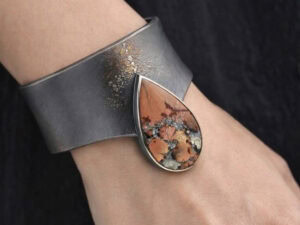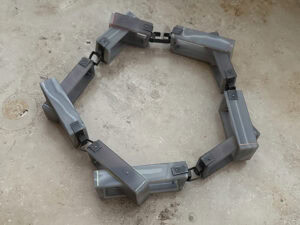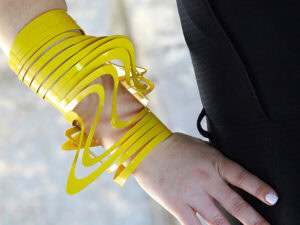Whatever words you want to use to attempt to describe the 275 pieces of art jewelry from Helen Drutt’s collection on display at the Museum of Fine Art Houston, no words seem to live up to the reality.
Even the professionals were at a loss. ‘We risk burying this exhibition in a heap of superlatives,’ confirms writer and curator Glenn Adamson. ‘In any context, this show would be a milestone.’ As an example, he points to the ‘contemporary feel and timelessness’ of Helen’s jewelry, collected from the 1960s on.
AJF member Cindi Strauss serves as curator for this superlative exhibit, called Ornament as Art: Avant-Garde Jewelry in the Helen Williams Drutt Collection, which premiered at the Museum of Fine Arts Houston (MFAH) on Friday, September 28, 2007.

AJF Houston trip planners Susan Cummins and Sally von Bargen didn’t miss a beat
– we were on the go, learning, seeing, doing, dining, exploring, shopping, collecting and experiencing a variety of wonders in Houston. Here are some highlights.
We honor Trish Rodimer: At dinner on our first night in town, on behalf of all AJF members Sally thanked outgoing AJF board members Elizabeth Shypertt, Rikka Mouw and Jo Lauria and gave a special thanks to Trish Rodimer for her service over the past nine years, seven of which she served as president. Trish has researched, planned and orchestrated many AJF trips, edited the hard-copy newsletter in earlier years and created our website. She received a Ford and Forlano brooch in recognition of all she’s done for AJF.
AJF gets a first peek: Cindi Strauss guided us through Helen’s collection the day before the official exhibition opening. After Helen, we were the first to see the completed installation, which dazzles us with its great use of light and the resulting shadows the jewelry creates
– the suspension of necklaces and brooches in cases where you can view them from a variety of angles and in the inventive use of mannequins (which Cindi admits she normally hates) to demonstrate clearly how certain pieces fit on the body. (Like that gorgeous collar of roses with a drop of dew by Gijs Bakker – ah, now I know how to wear it!)
We loved it. ‘It brought tears to my eyes to see these pieces in person that I had previously only seen in books,’ says collector Susan Beech. ‘I wanted to rip those three gold and plastic rings by Claus Bury right out of the case!’
Helen’s ‘aha’ moment: Cindi explained to us how she organized the exhibit and she pointed out the specific Stanley Lechtzin brooch that started Helen’s journey (her ‘aha’ moment, as it were).
As you can see from the encyclopedic, eight-pound exhibition catalog, a must-have for every serious jewelry collector, Helen’s collection spans eighteen countries and numbers more than 700 pieces. Helen’s collection also offers one common denominator that her dear friend Ann Tucker, curator of photography at MFAH, succinctly clarified for Helen and the rest of us. ‘Helen, your intelligence shows in every choice you made.’
While this is true, Cindi needed to present Helen’s collection in terms that would help both the knowledgeable and the neophyte understand and appreciate. Here’s how she did just that. The exhibit begins with a chronological overview featuring key works and then continues by examining three themes in depth: narrative impulses, the influence of twentieth-century art movements on contemporary jewelry and the role of the body and performance art.
If you miss this exhibit in Houston, it will travel, perhaps to a venue near you: the Renwick (March to June 2008), the Mint Museum, Tacoma Art Museum and a possible European venue. It will be back in Houston in time for SNAG’s 2010 conference.
Meeting with Helen: The day before the exhibition opening, we benefited from some private time with Helen and a few of the jewelry artists whose work she has collected: Bruce Metcalf, Peter Chang, Robert and Louise Smit and Peter Skubic.
Noting the genealogy aspect of Helen’s collection
– she bought from artist professors and then from their students’s MFA exhibits and beyond
– Robert Smit advises, ‘When you finish the school, you have to kill the teacher.’ Bruce Metcalf adds, ‘When it’s been codified in the academy so that one can teach it, its moment is over.’ Peter Chang changes the subject, just slightly: ‘Just as music is art, so is jewelry.’
We learned new terms: social jewelry is what Helen calls the jewelry made of precious materials worn on mainly formal social occasions. For Helen, an extremely important aspect of her collection stems from the friendships she developed with the artists. They became an extended family. In fact, more than 25 artists arrived from all over the world to celebrate this event with Helen
– quite a tribute.




